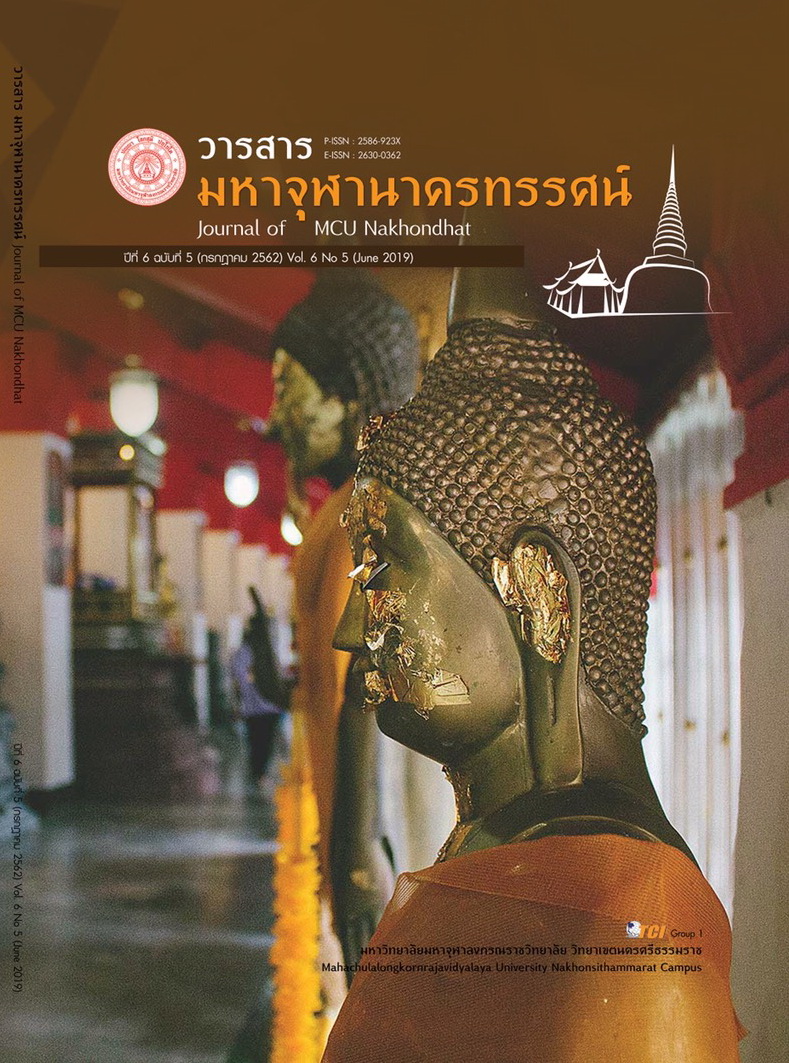SELF-EMPOWERMENTMODELSTHATAFFECTCOPINGANDOBSTACLES OF WOMEN HAVE BEEN SEXUALLY ABUSED
Main Article Content
Abstract
This article is part of the dissertation entitled " Self-empowerment models that affect coping and obstacles of women have been sexually abused". The objective is to study model self-efficacy that impacts on coping. and to study the effectiveness of self-efficacy models that affect the coping mechanisms and obstacles faced by women who have been abused. Sex By using research and development model. There are two stages of research: 1) Modeling and 2) By measuring the ability to face and obstacle. The sample consisted of 14 sexually abused women, divided into 7 control groups and 7 experimental groups using two experimental groups. Test before and after trial Data were analyzed by Wilcoxon test and Kruskal and Wallis tests.
The results were found :
1) The study found the model of the power of self-created by the researcher consists of 5 elements: principles and objectives, content, teaching process and evaluation. There are 6 teaching steps: (1) Problem solving (4) Data collection to summarize (5) Evaluation and improvement (6) Value and empowerment
2) The results of the study on the ability to face and overcome the barriers of women who have been sexually abused showed that: (1) coping ability and obesity of the abused women The experiment was significantly higher than before the experiment at the level of .05 (2) Experienced women There was a statistically significant difference at .05 level between the control group and the control group
3) New body of knowledge, including the insertion of Buddhist principles on modeling power in oneself so as to be a guideline for behavior development and attitude. The principle of Buddhist counseling can result in problems and obstacles And help to restore, strengthen the ability by practicing mindfulness and practicing patience and adjusting life balance which emphasis on mental development resulting in behavior development
Article Details
References
เกริกวิช บุญรักษา. (2551). ความสามารถในการเผชิญและฝ่าฟันอุปสรรคของนักกีฬาฟุตบอลชาย ผู้สังกัดทีมและผู้ไม่สังกัดทีม. ใน วิทยานิพนธ์ศึกษาศาสตรมหาบัณฑิต คณะศึกษาศาสตร สาขาจิตวิทยาการศึกษาและการแนะแนว. มหาวิทยาลัยเชียงใหม่.
นันทิยา วชิรลาภไพฑูรย์. (2547). การเพิ่มระดับความสามารถในการเผชิญและฟันฝ่าอุปสรรค โดยการเรียนรู้พฤติกรรมการเผชิญและฟันฝ่าอุปสรรค : กรณีศึกษาเยาวชนกระทำผิดชาย. ใน วิทยานิพนธ์ศิลปศาสตรมหาบัณฑิต คณะศิลปศาสตร. มหาวิทยาลัยธรรมศาสตร์.
ภัทรพร สิริกาญจน และคณะ. (2546). การประยุกต์ศาสนามาใช้ในการดำเนินชีวิต ความรู้พื้นฐานทางศาสนา พิมพ์ครั้งที่ 4. กรุงเทพมหานคร: โรงพิมพ์มหาวิทยาลัยธรรมศาสตร์.
มาลี จฑา. (2544). การประยุกต์จิตวิทยาเพื่อการเรียนรู้. กรุงเทพมหานคร: อักษราพิพัฒน์.
วีระวัฒน์ ปันนิตามัย. (2551). เชาวน์อารมณ์ ดัชนีเพื่อความสุขและความสำเร็จของชีวิต ฉบับปรับปรุงเพิ่มเอคิวและอีคิว พิมพ์ครั้งที่ 7. กรุงเทพมหานคร : สำนักพิมพ์แห่งจุฬาลงกรณ์มหาวิทยาลัย.
สำนักงานเลขาธิการสภาการศึกษา . (2560). แผนการศึกษาแห่งชาติ พ.ศ.2560-2579. เรียกใช้เมื่อ 1 ธันวาคม 2560 จาก www.moe.go.th/moe/th/news/ detail.php?NewsID = 47936&Key=news20
สำนักงานเลขาธิการสภาการศึกษา. (2552). ข้อเสนอการปฏิรูปการศึกษาในทศวรรษที่สอง (พ.ศ. 2552-2561). กรุงเทพมหานคร: พริกหวานกราฟฟิค จำกัด.
สำนักงานเลขาธิการสภาการศึกษา. (2553). แผนการศึกษาแห่งชาติ ฉบับปรับปรุง (พ.ศ. 2552-2559). กรุงเทพมหานคร: พริกหวานกราฟฟิค จํากัด.
สุธิดา พลชำนิ. (2555). การสร้างเสริมความสามารถในการเผชิญอุปสรรคของนิสิตนักศึกษาไทย. ใน วิทยานิพนธ์ครุศาสตรดุษฎีบัณฑิต สาขาวิจัยอุดมศึกษา คณะครุศาสตร์ . จุฬาลงกรณมหาวิทยาลัย.


